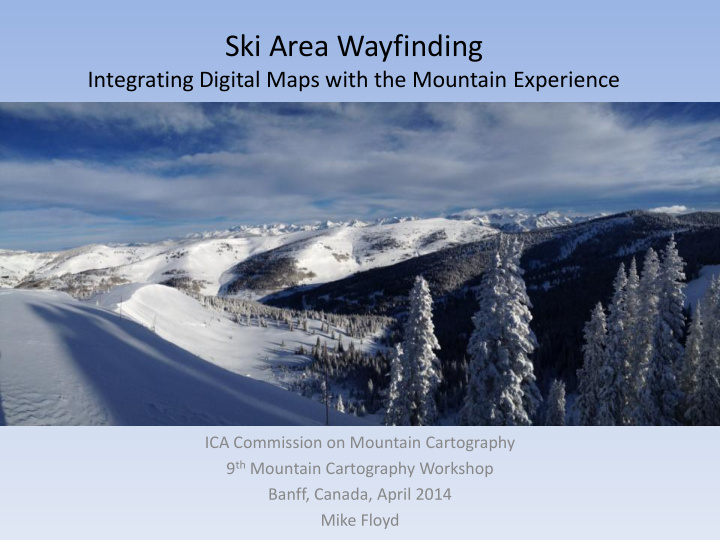



Ski Area Wayfinding Integrating Digital Maps with the Mountain Experience ICA Commission on Mountain Cartography 9 th Mountain Cartography Workshop Banff, Canada, April 2014 Mike Floyd
The Problem • Skiing: the bigger the terrain, the better • But wait….. • Skier numbers are declining across the industry • Ski Patrol: people get hurt and lost; patrollers respond, putting their lives on the line • Risk Management: protect employees and guests • Cartography as a wayfinding tool
How often do significant injuries occur? • Skier injury rate: 1 per 1000 skier days • Snowboarding injury rate: 1 per 600 days • On an average midwinter weekend day: 30-60 people are injured and receive treatment from ski patrol • Number of injuries is consistent, nature and severity changes with snow conditions • Injury rates in Colorado decreased until 2006, increasing since then -X-Games/Red Bull effect?
Why do people get hurt? • Skiing/riding too fast for conditions • Distracted • Terrain was too difficult • Tried a shortcut and ended up confused then lost then injured
Who gets hurt? • Predominantly beginner and intermediate skiers – most injuries are minor extremity injuries – Less than 50% require surgery • Advanced skiers are injured less often but more severely • 8% of patrol dispatches are for uninjured guests who are “lost” – 95% of these guests are from Latin America
What if people had better information to make decisions? • Town of Vail wayfinding project started summer 2013 – People who feel at ease in their surroundings are more likely to spend $$$ • Above average snowfall during the winter of 2013-2014 – More rescues occurred in remote areas within the ski area – More snow means additional work for patrollers (avalanche mitigation, digging out ski lift towers, etc.)
Proposed Solutions • Maps by cartographers NOT graphic designers – International guests in mind – Create a visual hierarchy • Quantify the dangerous places using GIS data derived from accident reports – Is this a dangerous place or just high volume of traffic?
Proposed solutions (cont.) • QR codes at key locations – Informal and formal surveys reveal a pattern of people getting lost in the same places Scan for directions
Proposed Outcomes (cont.) • Different map product for kiosks, folded maps, and mobile devices • GIS data available for other mountain departments – Snowmaking lines, utilities, roads, avalanche mitigation
1975
1980
1987
1999
2014
Desired Outcomes • Injury rates decrease • Number of patrol dispatches decreases • Guest experience improves
Less Desired Outcomes • Relocate the problem – People still get hurt, but they are finding new and equally treacherous places to do it
Thanks for listening! Mike Floyd cedarcanvas@gmail.com Cedar Canvas Cartography, Vail, CO, USA
Recommend
More recommend